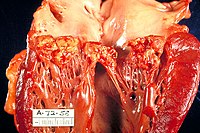
Photo from wikipedia
Background Libman-Sacks endocarditis in patients with systemic lupus erythematosus (SLE) is commonly complicated with embolic cerebrovascular disease (CVD) or valve dysfunction for which high-risk valve surgery is frequently performed. However,… Click to show full abstract
Background Libman-Sacks endocarditis in patients with systemic lupus erythematosus (SLE) is commonly complicated with embolic cerebrovascular disease (CVD) or valve dysfunction for which high-risk valve surgery is frequently performed. However, the role of medical therapy alone for Libman-Sacks endocarditis and associated acute CVD remains undefined. Objective To determine in this cross-sectional and longitudinal study if conventional anti-inflammatory and anti-thrombotic therapy may be an effective therapy in SLE patients with Libman-Sacks endocarditis and associated acute CVD. Methods and materials 17 SLE patients with Libman-Sacks endocarditis detected by two-and-three-dimensional transesophageal echocardiography (TEE) and complicated with acute CVD [stroke/TIA, focal brain injury on MRI, or cognitive dysfunction] were treated with conventional anti-inflammatory and anti-thrombotic therapy for a median of 6 months and then underwent repeat TEE, transcranial Doppler, brain MRI, and neurocognitive testing for re-assessment of Libman-Sacks endocarditis and CVD. Results Valve vegetations decreased in number, diameter, and area (all p ≤0.01); associated valve regurgitation significantly improved (p = 0.04), and valve thickening did not progress (p = 0.56). In 13 (76%) patients, valve vegetations or valve regurgitation resolved or improved in number and size or by ≥1 degree, respectively, as compared to 4 (24%) patients in whom vegetations or valve regurgitation persisted unchanged or increased in size or by ≥1 degree (p = 0.03). Also, cerebromicroembolism, lobar and global gray and white matter cerebral perfusion, ischemic brain lesion load, and neurocognitive dysfunction resolved or significantly improved (all p ≤0.04). Conclusion These preliminary data suggest that combined conventional anti-inflammatory and antithrombotic therapy may be an effective treatment for Libman-Sacks endocarditis and its associated CVD and may obviate the need for high-risk valve surgery.
Journal Title: PLoS ONE
Year Published: 2021
Link to full text (if available)
Share on Social Media: Sign Up to like & get
recommendations!